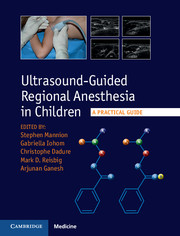Book contents
- Frontmatter
- Contents
- List of contributors
- 1 Introduction
- Section 1 Principles and practice
- Section 2 Upper limb
- Section 3 Lower limb
- 11 Ultrasound-guided femoral nerve block
- 12 Ultrasound-guided saphenous nerve block
- 13 Ultrasound-guided sciatic nerve block
- Section 4 Truncal blocks
- Section 5 Neuraxial blocks
- Section 6 Facial blocks
- Appendix: Muscle innervation, origin, insertion, and action
- Index
- References
11 - Ultrasound-guided femoral nerve block
from Section 3 - Lower limb
Published online by Cambridge University Press: 05 September 2015
- Frontmatter
- Contents
- List of contributors
- 1 Introduction
- Section 1 Principles and practice
- Section 2 Upper limb
- Section 3 Lower limb
- 11 Ultrasound-guided femoral nerve block
- 12 Ultrasound-guided saphenous nerve block
- 13 Ultrasound-guided sciatic nerve block
- Section 4 Truncal blocks
- Section 5 Neuraxial blocks
- Section 6 Facial blocks
- Appendix: Muscle innervation, origin, insertion, and action
- Index
- References
Summary
Clinical use
Femoral nerve block (FNB) under ultrasound guidance is very popular among pediatric anesthesiologists or emergency department physicians to efficaciously relieve pain after femoral shaft fracture or hip and knee surgery (Dadure et al., 2009; Flack and Anderson, 2012; Frenkel et al., 2012).
Once the FNB is performed the quadriceps muscle, periosteum and the skin of front of thigh and the medial aspect of the knee, leg, ankle and foot are usually anesthetized.
Compared with neurostimulation, ultrasound-guided FNB results in greater success rates, permits a 50% reduction in local anesthetic (LA) volume and displays prolonged analgesia (Oberndorfer et al., 2007; Ponde et al., 2013). In addition, ultrasound-guided FNB can be performed when neurostimulation is hampered by certain circumstances, i.e. concurrent use of neuromuscular-blocking drugs, arthrogryposis, joint immobilization, muscles disorders, or fractured lower limb when eliciting painful muscle movements should be avoided (Oberndorfer et al., 2007; Dadure et al., 2009). Another advantage of an ultrasound approach is to clearly visualize and identify the vessels or soft tissue of primary importance (Flack and Anderson, 2012).
Clinical sonoanatomy
The femoral nerve is formed from anterior branches of the L2, L3, and L4 spinal nerves before exiting the pelvis and entering the thigh under the inguinal ligament (Figure 11.1). The femoral artery and vein lie immediately medially to the nerve in the configuration nerve, artery, vein, or NAV. The femoral nerve appears triangle or sail-like and is superficial to the quadriceps muscles (Figure 11.2).
Landmarks
Depending on whether the anesthesiologist is right-or left-handed, the ultrasound machine is generally placed to the opposite side of the operator and the practitioner faces the screen. With the child usually in the supine position, the femoral region is best visualized when the lower limb is slightly abducted with external rotation. Under ultrasound guidance, a high-frequency linear array probe is positioned in the inguinal crease (parallel and just below the inguinal ligament) and placed perpendicular to the nerve axis (Figure 11.3). After a transverse back and forth scan (with gentle slide/tilt/rotation), the femoral nerve is easily located laterally to the femoral artery (the latter appearing as an anechoic circular non-compressive pulsatile structure; Doppler ultrasound might be helpful to identify the femoral artery for beginners). Ultrasound guidance may reduce the risk of femoral artery puncture compared with conventional techniques.
- Type
- Chapter
- Information
- Ultrasound-Guided Regional Anesthesia in ChildrenA Practical Guide, pp. 85 - 89Publisher: Cambridge University PressPrint publication year: 2015



